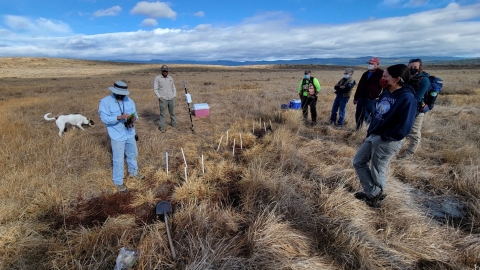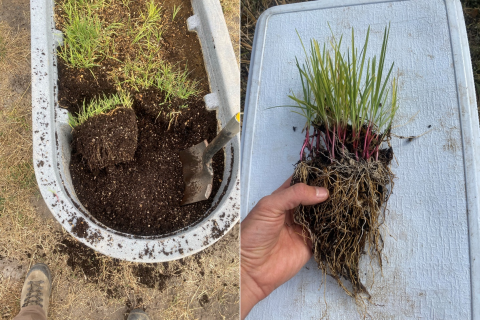On an October morning in 2021, three Burns Paiute Tribe wildlife program staff, one USDA-Agricultural Research Service ecologist, eight volunteers organized by Portland Audubon, and one U.S. Fish and Wildlife Service archaeologist arrived at the mountain meadows of Logan Valley with shovels, buckets, and two coolers full of the rarest grass in Oregon. This was the third year in a row that Tribal wildlife program staff and volunteers met to expand the introduced population of Oregon semaphore grass (Pleuropogon oregonus) at the Tribe’s Logan Valley property.
Logan Valley sits below the Strawberry Mountain Wilderness and includes wet meadows, wetlands, sagebrush sagebrush
The western United States’ sagebrush country encompasses over 175 million acres of public and private lands. The sagebrush landscape provides many benefits to our rural economies and communities, and it serves as crucial habitat for a diversity of wildlife, including the iconic greater sage-grouse and over 350 other species.
Learn more about sagebrush steppe, forest, and aspen stands. Logan Valley was an area of great importance to the Wadatika people, the ancestors of the Burns Paiute, and it remains important to the Tribe today. In 2000, the Burns Paiute Tribe purchased 1,760 acres in Logan Valley as a wildlife mitigation site with Bonneville Power Administration funds. As a wildlife mitigation site, the property is dedicated to wildlife habitat management and protection. In more than 20 years of managing the property, the Burns Paiute Tribe wildlife program has conducted many habitat and monitoring projects, including forest thinning, riparian riparian
Definition of riparian habitat or riparian areas.
Learn more about riparian plantings, bird surveys, amphibian surveys, and an American kestrel and Mountain bluebird nest box monitoring program. One of the longest projects the wildlife program has been involved with is their work with Oregon semaphore grass.
Oregon semaphore grass is a bit of an enigma. It is only known from two natural population clusters in Union and Lake Counties, separated by approximately 230 miles. It is so rare that the species was once thought to be extinct in the wild until it was rediscovered in 1982. Because of the small area where this species was found and the large distances between populations, the species is at risk of extinction. Given these circumstances, the Oregon Department of Agriculture (ODA) started collecting Oregon semaphore grass seeds and plants in 2000 to develop propagation protocols for the species. Luckily, ODA found the species was easy to propagate under controlled conditions. However, getting it established at introduced sites proved challenging. While ODA has attempted many introductions, only one introduction site has shown long term success and continued viability. That introduction site is in Logan Valley.
In the early 2000’s, ODA was searching for suitable public land to introduce populations of Oregon semaphore grass. ODA was unable to find suitable habitat on public land near the northern population of Oregon semaphore grass, but they did find Logan Valley. Logan Valley has a similar elevation, vegetation community, and saturated soils to the two natural population clusters. It is also protected as a wildlife mitigation site. ODA worked with Tribal wildlife program staff to pick planting locations and introduced Oregon semaphore grass to the property in October 2002. While many other introduction sites were attempted in the early 2000’s, Logan Valley was the only one that showed promise. ODA worked with Tribal wildlife program staff on additional plantings in 2009, 2010, 2011, 2012, and 2017 to continue building the population and conduct plantings on adjacent Forest Service land.
In 2018, The Tribal wildlife program obtained permits from ODA to start propagating Oregon semaphore grass and continue expanding the population at Logan Valley. This pilot project was successful and led to planting 19 new plots with Portland Audubon volunteers in October 2019. Following this success, the Tribal wildlife program successfully applied for a U.S. Fish and Wildlife Service Tribal Wildlife Grant in 2020. This grant has allowed the Tribal wildlife program to scale up their work with Oregon semaphore grass. It funds three additional years of propagation, three years of planting with Portland Audubon, and four years of monitoring the plantings. In addition, it has allowed the Tribal wildlife program to partner with Stella Copeland and Erik Hamerlynck, scientists from the USDA-Agricultural Research Service out of the Eastern Oregon Agricultural Research Center, to help study the environmental factors affecting Oregon semaphore grass establishment. This research should help clarify why the plantings have been successful at Logan Valley but not in other places. The results will be helpful in determining future planting locations both at Logan Valley and other properties in the future.
Another part of the project funded by this grant allowed the Tribal wildlife program to partner with Rob Massatti, a scientist at the United States Geological Survey Genetics for Western Restoration and Conservation group. Massatti will help investigate patterns of genetic diversity in both the natural and introduced populations. This is particularly exciting, as most people that have worked with this species assume that the two natural populations are different, given the large geographical distance between them and slight differences in appearance. However, no one has looked at the genetics of this species to determine if the two populations are genetically different and by how much. The results from this research will have implications for future restoration work and conservation of this species.
This grant has been crucial to expanding the Tribal wildlife program’s work with Oregon semaphore grass. Because of that work, we should learn a great deal about this species over the next few years, and the Tribal wildlife program will hopefully be doubling the size of the most successful introduced population of the rarest grass in Oregon.





